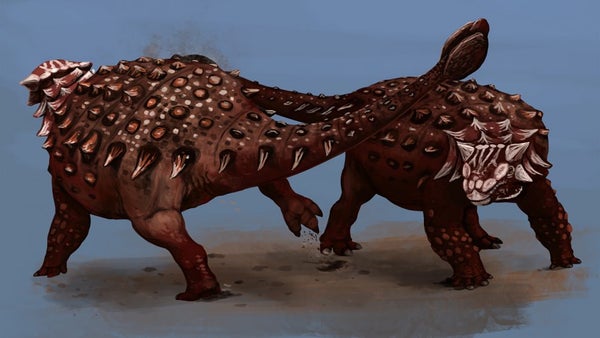This article was published in Scientific American’s former blog network and reflects the views of the author, not necessarily those of Scientific American
Every now and then I like to flip through old dinosaur books to see what’s changed. It’s not just the science that has matured. The thoroughly modern dinosaur is understood as an animal – reconstructed through what we can glean about its diet, motion, physiology, and behavior – while the saurians who roamed late 19th- and early 20th-century titles were usually cast as Prehistoric Monsters. They were both aberrant and stupendous, fierce but doomed to fail, and this often required the inclusion of armored dinosaurs like Stegosaurus and Ankylosaurus.
There's no modern equivalent for these osteoderm-covered reptiles. In the dusty old picture books, they seem to embody the entire contradiction of dinosaurian success, where armor plate – and not brains – made the difference in dominance over the planet. But even though we’ve moved away from characterizing dinosaurs this way, armor-bearing dinosaurs with frightening tail weapons still stand out within evolution’s broader menagerie. The same can be said of the turtles and glyptodonts (mammals related to armadillos) that also evolved their own spiky weaponry. Why did these armaments evolve multiple times but seem to be absent today, throwing the prehistoric tail-bashers into high contrast? That question is at the center of a new study by paleontologists Victoria Arbour and Lindsay Zanno.
Ankylosaurs, ninja turtles, and glyptodonts really do stand out as exceptions against the background pattern of amniote evolution. To understand what may have led these animals to independently evolve similar defenses, then, Arbour and Zanno surveyed the amniote family tree for creatures who use their tails as weapons and cataloged the anatomical and ecological traits they had in common.
On supporting science journalism
If you're enjoying this article, consider supporting our award-winning journalism by subscribing. By purchasing a subscription you are helping to ensure the future of impactful stories about the discoveries and ideas shaping our world today.
After comparing 286 species over a 300-million-year span, Arbour and Zanno found that amniotes with bony tail weapons shared a few traits with each other and to the exclusion of others. Despite being distantly-related, the tail-swingers were usually large and had some kind of body armor like a shell or rows of osteoderms. The core of their bodies – the thorax – was also relatively stiff in terms of side-to-side motion, as well, and all were herbivores. Even dinosaurs that aren’t typically thought of in this category – like some titanosaurs with tail clubs – fit this pattern. If you’re a large herbivore with body armor, the prerequisites for evolving a tail club are mostly met.
If these characteristics really do go together as a defensive package, Arbour and Zanno point out, it may explain why we don’t see equivalent animals today. The glyptodonts went extinct around 10,000 years ago – a void no other mammal has stepped into – and the largest land-dwelling turtles usually have short tails and don’t use them as flails. The right combination of traits hasn’t yet re-occurred. But it could. Given that tail spikes, clubs, and other weapons have evolved multiple times since the Jurassic, it’s probably only a matter of time before some other amniote lineage does the same. I’m just a little sad we probably won’t be around to see it.
